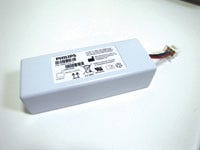April 6, 2011
Return to Article: |
A common refrain from custom lithium-ion (Li-ion) battery pack manufacturers is to involve them as early in the design process as possible to avoid complications down the line and delaying time to market. Our experts offer five tips for avoiding common mistakes when designing power sources for portable medical applications.
Understand your application requirements. Engineers need to know their system's voltage, capacity, and current requirements in order to determine the proper power system. Current requirements, in particular, are often overlooked by engineers, notes Robin Tichy of Micro Power. "In some ways, the current will actually affect what type of capacity you need," she cautions. "You need a bigger battery to support higher current, for example." Furthermore, there may be more to current requirements than engineers initially realize, according to George Cintra of Electrochem. "Often times, engineers say that the system needs 2 A to [perform], but what is often not understood is: Is there a peak current load at some point in the load regime? In this case, we have to make sure that the battery can handle not only an average current but a peak load current as well."
|
Rechargeable lithium-ion battery packs can include sophisticated battery-management electronics such as cell balancing or fuel gauging. |
Consider the location. As the saying goes: Location is everything. This adage also applies to the location of the battery pack within the portable medical system. Proximity of the battery pack to system electronics can impact capacity because of the heat generated from a convertor or other components. "Knowing where the battery pack is located in relation to the device electronics is important because you can mind the heat impact--or at least be able to deal with it--by configuring the pack in a certain way that more evenly distributes the heat," Cintra says.
Dedicate sufficient space in the system. Batteries need a bit of breathing room during normal charge and discharge cycles; but, engineers often don't account for this space, explains Mel Weis of House of Batteries. In addition, the space allocated in the system for the battery pack may not accommodate the battery size required for the desired run time, for instance. As a result, battery pack manufacturers may be forced to scramble to modify the mechanical design of the battery pack to accommodate larger cells than expected or even turn down the project if it is deemed too late in the process. "Engineers often come to us with a certain cavity size that is already preventing the correct battery size to be designed in, so there's already a lot of restriction," Weis says. "What's needed is a lot of front-end collaboration between the two companies to develop the power solution for the product versus on the back end where they think it's going to be a simple solution."
Allow ample lead time. As Weis notes, developing a Li-ion power solution for portable medical systems is not as quick and easy as engineers may perceive it to be. "Engineers think of the battery pack as a fairly simple part of their equipment, and so they look to source the battery when their product is fairly far down in the design cycle," Tichy remarks. "But custom battery packs take a fair amount of time to design, so the earlier the OEM engages a battery expert, the better off it's going to be." Design cycles for a battery pack can range from roughly six months to a year, Tichy adds. The bulk of this time is dedicated to rigorous regulatory testing required to comply with UL guidelines and UN-DOT transportation tests. If engineers wait until the last minute for custom battery pack design, they may have to face delayed time to market.
Allocate the proper budget. Not only is the UN-DOT shipping test time-consuming, it also carries a hefty price tag that often catches OEMs off guard, Weis says. He notes that the test typically costs about $5000. A number of packs must also be submitted for testing, which can add up. These testing requirements, along with the added required safety battery-management electronics, make rechargeable Li-ion a significantly higher-cost option than nickel chemistries, Weis adds. "But it allows for smaller products to be presented on the market, so you get more energy or equal energy with fewer connections and electronics."
About the Author(s)
You May Also Like



